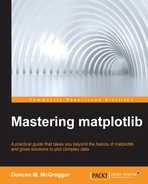Over the past 12 years of its existence, matplotlib has made its way into the classrooms, labs, and hearts of the scientific computing world. With Python's rise in popularity for serious professional and academic work, matplotlib has taken a respected seat beside long-standing giants such as Mathematica by Wolfram Research and MathWorks' MATLAB products. As such, we feel that the time is ripe for an advanced text on matplotlib that guides its more sophisticated users into new territory by not only allowing them to become experts in their own right, but also providing a clear path that will help them apply their new knowledge in a number of environments.
As a part of a master class series by Packt Publishing, this book focuses almost entirely on a select few of the most requested advanced topics in the world of matplotlib, which includes everything from matplotlib internals to high-performance computing environments. In order to best support this, we want to make sure that our readers have a chance to prepare for the material of this book, so we will start off gently.
The topics covered in this chapter include the following:
- A brief historical overview of matplotlib
- What's new in matplotlib
- Who is an advanced, beginner, or an intermediate matplotlib user
- The software dependencies for many of the book's examples
- An overview of Python 3
- An overview of the coding style used in this book
- References for installation-related instructions
- A refresher on IPython Notebooks
- A teaser of a complicated plot in matplotlib
- Additional resources to obtain advanced beginner and intermediate matplotlib knowledge
The open source project that we now know as matplotlib had its inception at the beginning of the millennium when John Hunter and his colleagues were conducting epilepsy research using proprietary data analysis software. They migrated to MATLAB as it was more flexible and less expensive. However, it was not designed to handle the data formats and diverse data sources that they had to contend with on a daily basis.
It was with this realization that John Hunter created the first version of matplotlib—a GTK+ visualization tool for electroencephalography and electrocorticography analysis. Having been built in Python, adding support for new features as the team needed them was a straightforward task. Before long, this led to the idea of providing a similar interactive command mode to generate plots on the fly, as MATLAB does.
One of the oldest sources available for matplotlib code online is the GitHub repository. The first commit in this repository was with regard to migration from Subversion to Git, though the original repository was CVS. This commit was authored in May 2003, though this repository records a CHANGELOG file whose first entry was made in December 2002. By the time this book goes into publication, matplotlib will have celebrated its 13th birthday.
